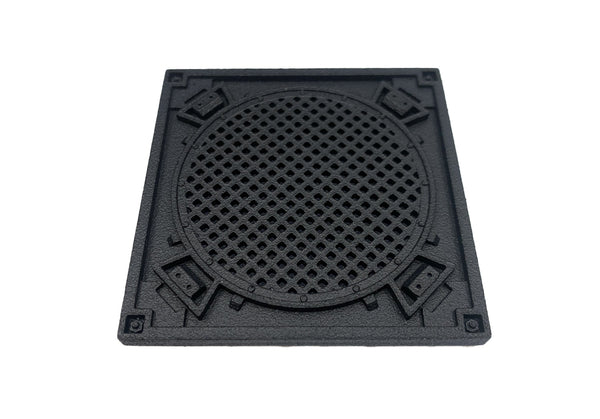Revell 1:35 Tiger II Ausf. B (Henschel Turret)
RV03249
£27.00 GBP
Revell 1:35 - Tiger II Ausf. B (Henschel Turret) - Plastic Model Kit #03249
Tiger II was a German heavy tank of the Second World War officially designated the Panzerkampfwagen Tiger Ausf. B. Based on the Tiger I, the Tiger II combined the thick armour of its predecessor and the armour slope of the Panther medium tank. The maximum thickness of its front armour was 185 mm and the weight reached 70 tonnes. The armament consisted of the long barrelled 8.8 cm KwK 43 L/71 gun which proved to be efficient against all Allied tanks.
The initial design of the Tiger II was developed in 1937 by the Henschel company. It featured a hull with sloped armour, a rear-mounted engine and overlapping steel-tired road wheels, 80 cm in diameter. Another design was developed by Porsche in 1939, but it was declined due to large production costs.
The Tiger II first saw combat during the Battle of Normandy in 1944. On the Eastern Front it was first used by the 501st Heavy Panzer Battalion. Fortunately for the Allies, German plants suffered great losses because of the Allied bombing, so a relatively small number of Tiger II's were built. Mass production ran from 1944 to the end of the war and only 492 units were produced during that period.
Kit details:
- Total parts: 250
- Skill Level: 4
- Length: 293mm
- Chassis with torsion bar suspension and easy to mount tracks
- Rotating turret and elevating gun
- Hatches that can be mounted open or closed
- Two sets of decals
Related Items
Soviet Sniper WW2 1/16th scale
£45.00 GBP
Highly detailed 1/16th or 120mm scale miniature, capturing the uniform and equipment of a WW2 Soviet Sniper. The kit comes with three head configuration options, fur hat with ear flaps known as the 'Ushanka', a head with helmet (2 parts) and a head with a cap known as the 'Pilotka'.
This is ideal for a diorama or bust depicting Soviet Snipers such as Vasily Grigoryevich Zaitsev. Between 10 October 1942 and 17 December 1942, during the Battle of Stalingrad, he killed 225 enemy soldiers. Zaitsev became a celebrated figure during the war and later a Hero of the Soviet Union, and he remains lauded for his skills as a sniper.
Operation Frankton RMBPD Set - WWII Cockle Canoe + Royal Marines
£45.00 GBP
1:35 - Major Herbert George "Blondie" Hasler - Resin kit
Herbert George "Blondie" Hasler was a Lieutenant Colonel of the Royal Marines. In 1942, a 28-year-old Hasler planned and led Operation Frankton. The operation was a commando raid on Axis shipping in the French port of Bordeaux occupied by the Germans. The mission was to attach mines to the hulls of German cargo ships. Three of the five canoes were lost on the way to the port. The surviving crewmen including Hasler reached the port successfully, placed the mines and managed to drown four cargo ships. They then walked 100 miles to a French village where they met with members of the Resistance and started their journey back to England through Spain and Gibraltar. For this operation Hasler was awarded the Distinguished Service Order by King George VI.
One kayak was damaged while being deployed from the submarine, and it and its crew therefore could not take part in the mission. Only two of the 10 men who launched from the submarine survived the raid: Hasler, and his number two in the kayak, Bill Sparks. Of the other eight, six were executed by the Germans and two died from hypothermia.
This product is available in two scales, 1:35 and 1:24 and was painstakingly designed from scratch as a digital model.
The kit includes: 2 x miniatures (Blondie Hasler and Bill Sparks) in their folding Cockle Canoe named 'Catfish' made by Campaign Models (UK).
Now available, while stocks last.
Miniature Diorama Display Base
£9.50 GBP
This highly detailed Diorama base is ideal for mounting one or two figures on display. Small enough to be displayed easily, big enough to provide enough space to set the scene. More styles coming very soon!
Dimensions: 58mm x 58mm x 4mm
1:35 Resin Miniature WWII German Soldier Eastern Front
£15.00 GBP
A detailed single (1x) resin miniature in 1:35 scale, posed to be standing while smoking a cigarette. The kit consists of the following parts:
Head/torso
Helmet
Right arm with MP40
Left arm/hand
Left leg
Right leg
M1931 Bread Bag - with M1931 Field Flask and Mess tin combined
Ammunition Pouch
Spare MP40
Sidearm in holster
















